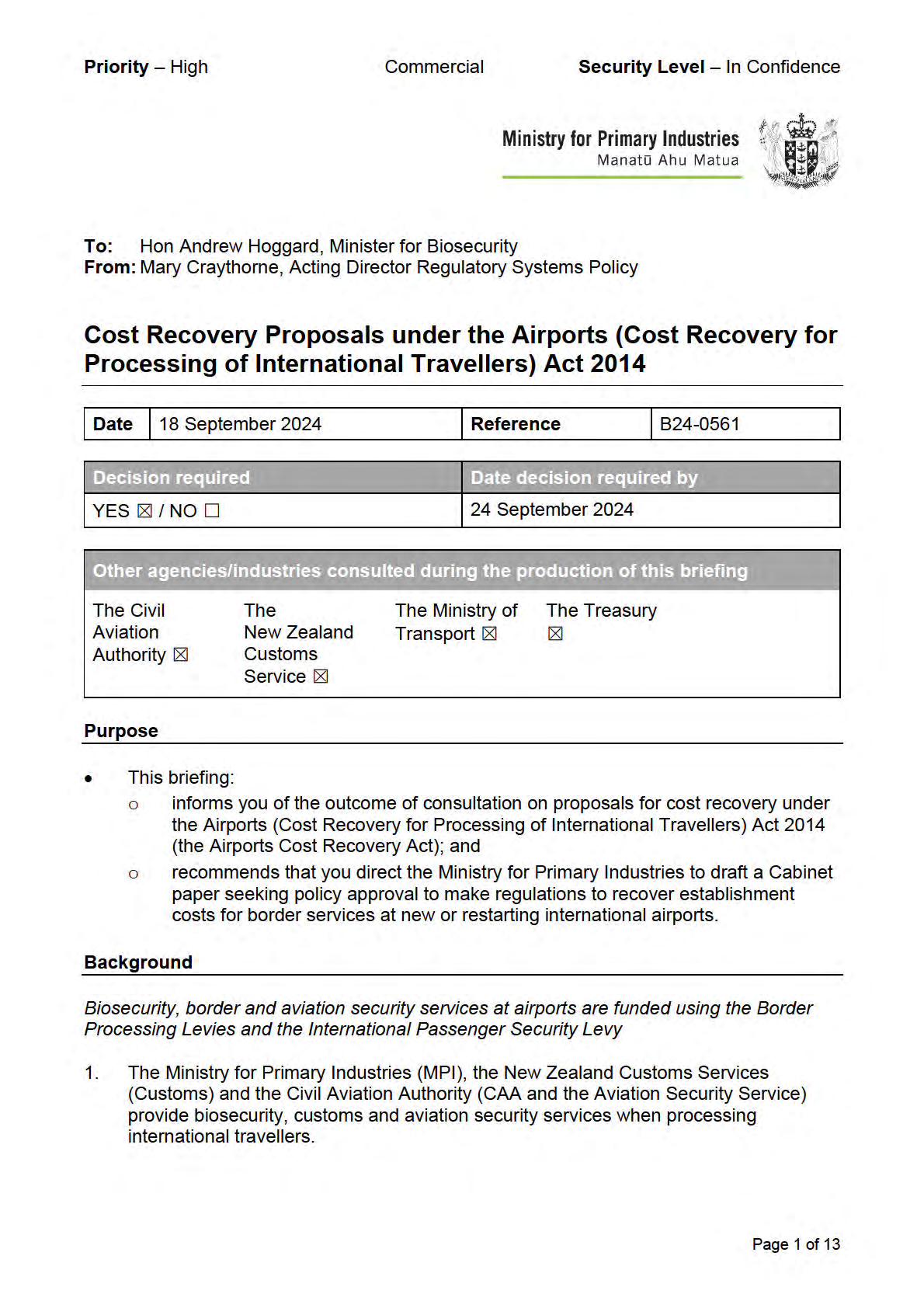
under the Official Information Act 1982
Released
B24-0561
2.
Services are funded through the following levies:
a)
MPI recovers costs for biosecurity services through a Border Processing Levy
(BPL) under the Biosecurity Act 1993 (Biosecurity Act);
b)
Customs recovers costs for border processing or passengers and their
accompanying goods through a Border Processing Levy (BPL) under the
Customs and Excise Act 2018 (Customs and Excise Act); and
c)
the CAA recovers costs for security services through the International Passenger
Security Levy (IPSL) under the Civil Aviation (Safety and Security) Levies Order
2002 (Civil Aviation Levies Order).
3.
The BPLs are payable by travellers and collected by airlines. They are set at a
standard rate per traveller to recover the nationwide costs of traveller processing by
border agencies. The IPSL is set at a standard rate and is payable by airlines on a per
passenger basis.
Previous Cabinet agreement for consultation on cost recovery proposals
4.
On 31 July 2024, you presented a Cabinet paper to the Economic Policy Cabinet
Committee (ECO) seeking Cabinet agreement to the release of the discussion
document that set out the cost recovery proposals under the Airports Cost Recovery
Act (B24-0387
Cabinet paper: Discussion Document for Cost Recovery Regulations
under the Airports (Cost Recovery for Processing of International Travellers) Act 2014,
Sub24-0071
Release of Discussion Document: Cost Recovery Regulations for the
Airports (Cost Recovery for Processing of International Travellers) Act 2014 and
ECO-24-MIN-0150).
5.
On 5 August 2024, Cabinet confirmed ECO’s agreement to the recommendations in
the Cabinet paper, including releasing the discussion document for a three-week
consultation during August 2024 [CAB-24-MIN-0290].
Outcome of targeted consultation
Consultation occurred over a three-week period from 7 to 28 August 2024
6.
The discussion document set out four options to enable MPI and Customs to cost
recover for border services at new or restarting international airports. The CAA
under the Official Information Act 1982
advised that the IPSL was sufficient to recover costs for establishing aviation security
services at new or restarting international airports. As such, the CAA did not seek to
be included in the proposed regulations.
7.
The four options were as follows:
a)
Option 1 - no regulations under the Airports Cost Recovery Act (the status quo);
b)
Option 2 - payment by airports based on estimated costs;
c)
Option 3A (preferred option) - recovery for establishment costs and site-specific
Released
operating costs from airports. All other operating costs (those costs that are not
site-specific) would be recovered under the BPLs. Site-specific operating costs
would include travel and accommodation costs for border agency staff coming to
an airport from another base of operations if it were not justifiable for those staff
Page 2 of 13
B24-0561
to be located permanently at the new airport (for example, if the airport received
fewer than seven international flights per week); and
d)
Option 3B (preferred option) - Recovery for establishment costs only from
airports, with all operating costs recovered under the BPLs.
8.
Officials held an initial webinar on 12 August 2024. A second webinar was hosted by
the New Zealand Airports Association (NZ Airports Association) on 21 August 2024.
Officials also presented at a regular stakeholder meeting hosted in Wellington by the
Civil Aviation Authority on 19 August 2024.
9.
Both webinars were well attended. Feedback was highly aligned across stakeholders
who told us:
a)
they opposed new regulations under Airports Cost Recovery Act, and preferred
funding services from the BPLs;
b)
new regulations would stifle growth and regional economic development
opportunities; and
c)
the Airports Cost Recovery Act was outdated and no longer fit-for-purpose.
10. Stakeholders also noted the cumulative impact of related government consultations
and fees changes on the sector, and on their ability to give feedback within our
timeframes.
We received 14 submissions largely opposed to new regulations
11. We received 14 submissions from airports, airlines, the NZ Airports Association, the
Board of Airline Representatives of New Zealand (BARNZ), and regional development
and tourism organisations.1 A submissions summary is attached at
Appendix One.
12. Submissions were highly aligned with feedback received during webinars. Almost all
submitters opposed new regulations under the Airports Cost Recovery Act. The
themes from the submissions are listed below:
a)
the BPLs should be used to fund the establishment costs for border services for
new or restarting international airports;
b)
the Airports Cost Recovery Act is outdated and should be reviewed and
repealed;
under the Official Information Act 1982
c)
new cost recovery regulations will disincentivise international airlines from
entering the New Zealand market, which will have negative flow on effects for
regional economic growth and tourism;
d)
a mixed model of cost recovery using the regulations and the BPLs will risk
double recovery from airports and travellers, that is by charging airports and
passengers for the same item or cost; and
e)
cross-subsidisation is an inherent and accepted part of New Zealand’s air
transport sector.
Released
1 We did not receive formal submissions from Auckland, Wellington, Christchurch or Queenstown Airports).
The NZ Airports Association submission states that it represents the views of all airports.
Page 3 of 13
B24-0561
13. One submitter (Air New Zealand) supported Option 3B. Their key concern was to
ensure a level of public accountability so that the BPLs are not used for purposes that
were not intended. Some submitters, while being opposed to new regulations, saw
Option 3B as the only palatable regulatory option under the Airports Cost Recovery
Act.
14. The NZ Airports Association submission included a legal opinion from Russell
McVeagh arguing that cost recovery provided for under the Airports Cost Recovery
Act can be fully recovered under the BPLs. Many submissions relied on this legal
advice.
15. The NZ Airports Association has subsequently forwarded this advice to you and
Hon Casey Costello, Hon Simeon Brown, Hon Matt Doocey and Hon Shane Jones
(MIN24-0751 refers).
Advice
16. There are several options available to you for cost recovery for border services at new
or restarting international airports. These options, along with a suggested decision-
making process, are summarised at
Appendix Two.
17. We recommend that you:
a)
agree to make regulations under the Airports Cost Recovery Act for
establishment costs only (Option 3B), with processing costs recovered under the
BPLs; and
b)
review the Airports Cost Recovery Act.
18. No submitters supported our alternative regulatory Options 2 or 3A. After considering
submissions, our view remains that while Option 2 is better than the status quo, it
does not promote certainty nor meet the efficiency criterion. Consultation confirmed
that Option 3A is administratively more complex than Option 3B, to a degree that we
do not recommend it proceed.
19. Option 1 (no regulations) is the status quo. The effect of this decision would be to
accept that the establishment costs of new or restarting services would fall largely with
the Crown. This is not recommended on the grounds of fiscal risk, and it is
under the Official Information Act 1982
inconsistent with the policy intent of the Airports Cost Recovery Act.
There are financial, risk management and equity reasons for not using the BPLs to fund
establishment costs
20. After carefully reviewing submissions, officials re-considered whether the BPLs should
be used to cost recover for new or restarting airports.
Released
Page 4 of 13
B24-0561
21. The Airports Cost Recovery Act has two objectives, namely to:
a)
reduce the Crown’s exposure to unpredictable and unlimited liabilities arising
from the processing of travellers on international flights; and
b)
ensure that airports factor in the costs of aviation security, biosecurity and
customs services associated with processing travellers on international flights
into their commercial decisions.
22. Our view is that both objectives are still relevant. We note that some submitters argue
that fiscal risk to the Crown can be managed by use of the BPLs. However, if
establishment costs are recovered via the BPLs, upfront costs will still need to be
borne by MPI and Customs and will only be recovered via the BPLs over time. Cost
recovery via the BPLs also means that agencies will not have up-front funding for
capital. The current fiscal environment practically constrains the ability for the Crown
to meet upfront establishment costs.
23. The implications of funding establishment costs at new or restarting international
airports via the BPLs would include shifting some commercial risk from airports to
another party (the Crown or passengers). This could incentivise new services at a
level beyond that could be supported by the sector.
24. Commercial negotiations with airlines for international services have a relatively short
turnaround. An increase in proposals from several airports would place resourcing
pressure on MPI, the CAA and Customs to meet demand without any effective levers
to influence efficient allocation of public resources. Establishing border services at a
new airport at short notice has to be prioritised within existing work programmes. This
heightens risks to the delivery of service quality and assurance of border outcomes.
25. There are also equity considerations. For example, should the BPLs be used to fund
establishment costs, travellers may end up cross-subsidising services they can never
use if an airport is subsequently disestablished.
Risks of disestablishment of services are real
26. Regional international services have started, then failed when routes became
uneconomic previously. Services have twice been disestablished at Hamilton Airport.
This has led to the Crown being liable for redundancy payouts as well as the risk of
under the Official Information Act 1982
stranded assets. For example, border staff from MPI and Customs were made
redundant in April 2009 following the end of international services from Hamilton.
Airports benefit from providing for international services and establishing a new point of
entry creates risk
27. A long-standing principle of cost recovery is that costs should be charged to those
who benefit from the service, or who create the need for services. Regulatory
proposals sho
Released uld ensure commercial enterprises are not implicitly or explicitly
subsidised; they should be making their commercial decisions with the full costs and
risks in mind.
Page 5 of 13
B24-0561
28. We do not find the argument in some submissions, that airports are not a beneficiary
of new international services, compelling. Airports are commercial entities incentivised
to maximise returns to their shareholders. We are not convinced that they would
consider new services in the absence of anticipated future financial returns.
29. The lack of support for regulations is not surprising. For many of our submitters, their
commercial drivers will be to reduce costs and shift risk to others.
30. We do not have strong evidence that cost recovery would disincentivise international
airlines from establishing routes. We note that Air New Zealand supported Option 3B
in their submission.
31. Some of the risks created by new services do not relate to passengers. For example,
pests could be introduced via craft movements alone. Insider threats (for example,
relating to drug smuggling or acts of terrorism) may also not be directly related to
passengers but stem from the establishment of international services themselves.
New services may help regional economic development
32. We accept that regional economic development may be stimulated by new services.
Regional and rural communities may also benefit from enhanced access to an
international gateway. However, it is also possible that the net impact would be to
redistribute current passengers across the network, rather than representing new
growth (or a significant net gain for the New Zealand economy).
33. The historical pattern of growth and scale of passengers from regional airports is very
small when compared with passenger arrivals at major airports. For example,
722,423 passengers arrived at Hamilton Airport over a 22-year period (between
1996 to 2018), which is 625 passengers per week. Auckland Airport processed
4.7 million international passengers in the 12 months ending July 2024, or an average
of 13,000 passengers arriving each day (refer to
Appendix Three).
34. If you are persuaded that policy considerations such as the regional economic benefits
of new services and enhanced competition in the aviation sector justify financial
support from the Crown, a way to achieve this could be to fund new services directly
from any regional economic development funds, rather than indirectly via passenger
levies.
under the Official Information Act 1982
Making regulations under the Airports Cost Recovery Act is justified, but the Act needs
reviewing
35. The rationale for making new regulations under the Airports Cost Recovery Act would
be to manage fiscal risk to the Crown as well as ensuring that commercial entities
factor in the costs of new services as part of their business cases. Based on our own
analysis and the views of submitters, Option 3B (recovering only establishment costs
Released
from airports, with processing costs recovered under the BPLs) is our recommended
option. This presents a reasonable balance between equity and efficiency
considerations, without large administrative costs.
Page 6 of 13
B24-0561
36. As noted in our earlier advice, we agree with many submitters’ views that the Airports
Cost Recovery Act requires a review. For example, it does not:
a)
consider costs of disestablishment;
b)
align with how capital and operating expenditure are currently treated within the
public finance systems;
c)
allow all border agencies (such as Immigration New Zealand and Health
New Zealand) to cost recover; or
d)
give a mechanism to recover costs for establishing freight-only operations.
37. Part of the policy intent in the legislative amendments which set up the BPLs is to
avoid double recovery between the levies and any regulations under the Airports Cost
Recovery Act. The lack of clarity in how the Airports Cost Recovery Act and the BPLs
work together could lead to (at least) the perception of double recovery.
38. In addition, should regulations be made under the Airports Cost Recovery Act, a minor
amendment to the Civil Aviation (Safety and Security) Levies Order is required.
39. To manage this risk and to ensure that the legislative framework is future-proofed,
should you wish to proceed with regulations, we recommend that we review the
Airports Cost Recovery Act. Any regulations made under this Act in the interim could
be reviewed simultaneously.
40. We do not recommend waiting for a review of the Airports Cost Recovery Act to enact
regulations. Jetstar has just confirmed three new trans-Tasman routes from Dunedin
and Hamilton airports. We are aware of other airports with start-up aspirations.
Certainty and a mechanism to manage fiscal risk is required urgently.
Financial impacts of different options are significant for airports but the impact on the BPLs
would likely be small
41. Our discussion document noted that establishment costs are very difficult to predict in
advance of any formal proposal being received. Geographical location, proximity to
another (already established) international airport, and whether the airport is new or
restarting all heavily influence the amount of costs recoverable.
s9(2)(b)(ii)
42.
under the Official Information Act 1982
43.
Released
s9(2)(b)(ii)
Page 7 of 13
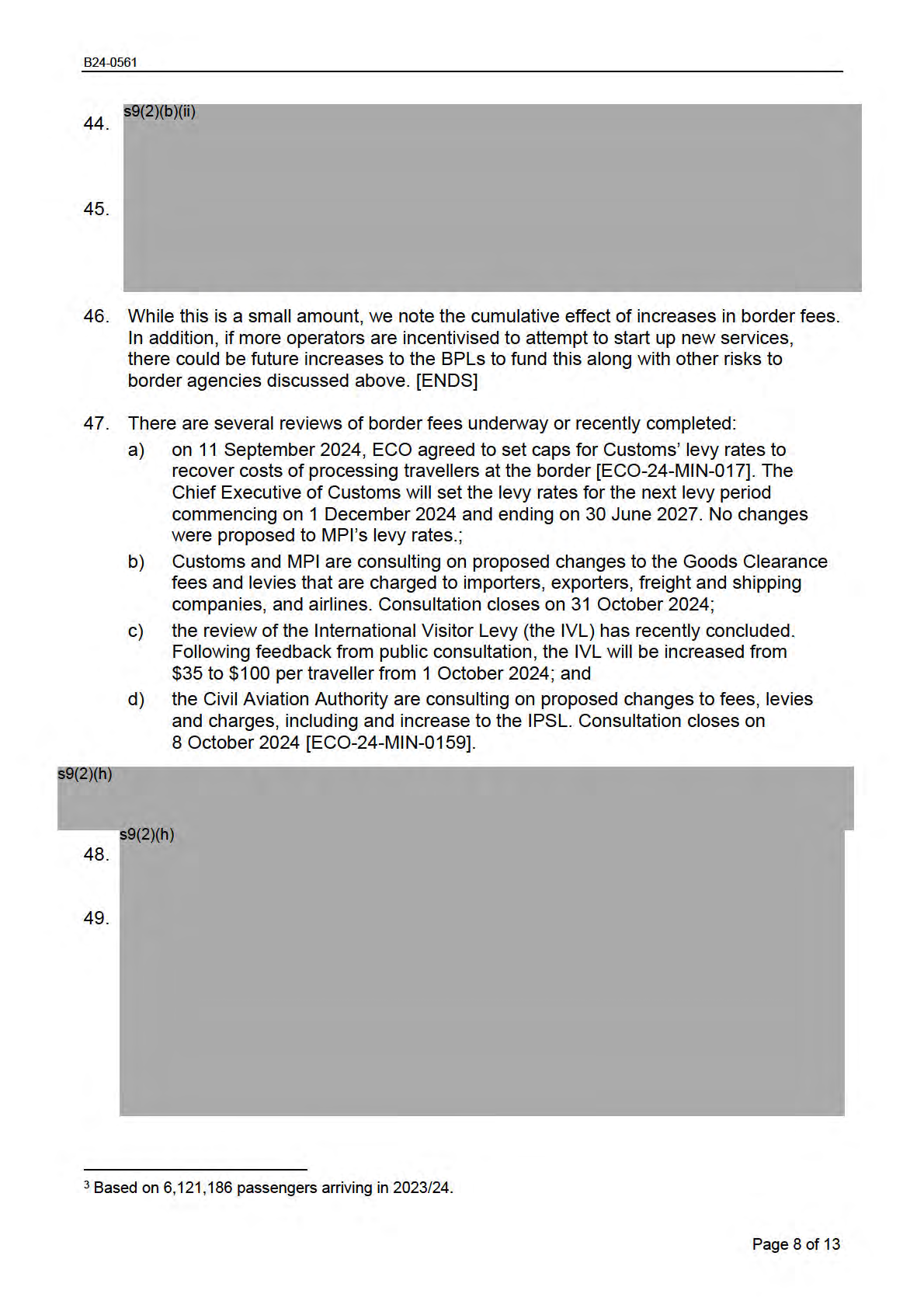
under the Official Information Act 1982
Released
B24-0561
s9(2)(h)
50.
51.
52.
53.
54.
55.
56.
Your decisions depend on whether you agree that the policy intent of the Airports Cost
Recovery Act still holds and s9(2)(h)
57. If you agree with our advice that the policy intent of the Airports Cost Recovery Act is
still relevant, then we recommend that you proceed with new regulations to recover for
under the Official Information Act 1982
establishment costs only (Option 3B). We also recommend that we review the Airports
Cost Recovery Act to ensure that it is fit-for-purpose in the current legislative
environment. We have called this
Package 1 in our recommendations below.
s9(2)(h)
58.
Released
59.
Page 9 of 13
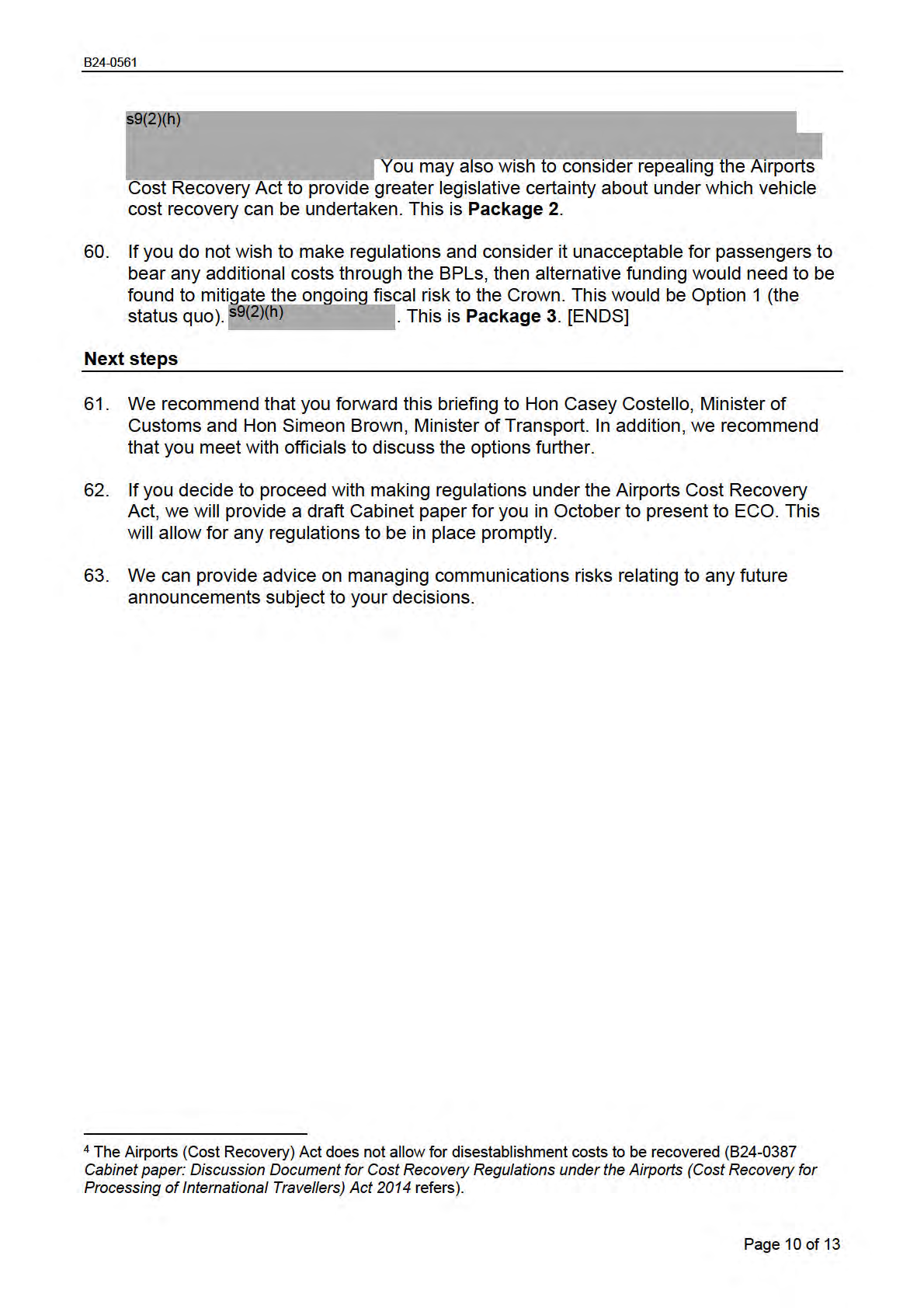
under the Official Information Act 1982
Released
B24-0561
Recommendations
1.
It is recommended that you:
a)
Note that officials have concluded consultation on cost recovery proposals
under the Airports (Cost Recovery for Processing of international Travellers)
Act 2014 (the Airports Cost Recovery Act).
NOTED
b)
Agree to meet with officials to discuss the advice presented in this briefing.
YES / NO
c)
Agree to forward this advice to the Minister of Customs and Minister of
Transport.
YES / NO
d)
Note that most submitters preferred funding establishment and operating
costs for border services for new or restarting international airports from the
Border Processing Levies (the BPLs).
NOTED
e)
Agree to choose one of the options presented below (Package 1, Package 2,
or Package 3).
YES / NO
under the Official Information Act 1982
Released
Page 11 of 13
B24-0561
Package 1: Make cost recovery regulations for establishment costs only
under the Airports Cost Recovery Act and review the Airports Cost
Recovery Act (recommended option)
h)
Agree to direct Ministry for Primary Industries (MPI) officials to draft a Cabinet
paper for your consideration recommending cost recovery regulations for
establishment costs only under the Airports Cost Recovery Act (Option 3B in
the discussion document for the Airports Act Cost Recovery proposals).
YES / NO
AND
i)
Agree to review the Airports Cost Recovery Act
YES / NO
OR
Package 2: Use the BPLs to cost recover for new or restarting
international airports with primary legislative change (not
recommended)
g)
Agree to use the BPLs to cost recover for new and restarting airports with
primary legislative change by:
a)
declining to make regulations under the Airports Cost Recovery Act;
under the Official Information Act 1982
b)
consider repealing the Airports Cost Recovery Act; and
c)
directing officials to work on amendments to the Biosecurity and
Customs and Excise Acts to ensure that all establishment and
disestablishment costs can be recovered.
YES / NO
Released
OR
Page 12 of 13

B24-0561
Package 3: Retain the status quo (no new regulations to recover
establishment costs for new or restarting international airports) (not
recommended)
j)
Decline making regulations under the Airports Cost Recovery Act (
not
recommended)
YES / NO
Mary Craythorne
Hon Andrew Hoggard
Acting Director, Regulatory Systems Policy
Minister for Biosecurity
Policy and Trade
/ / 2024
under the Official Information Act 1982
Released
Page 13 of 13
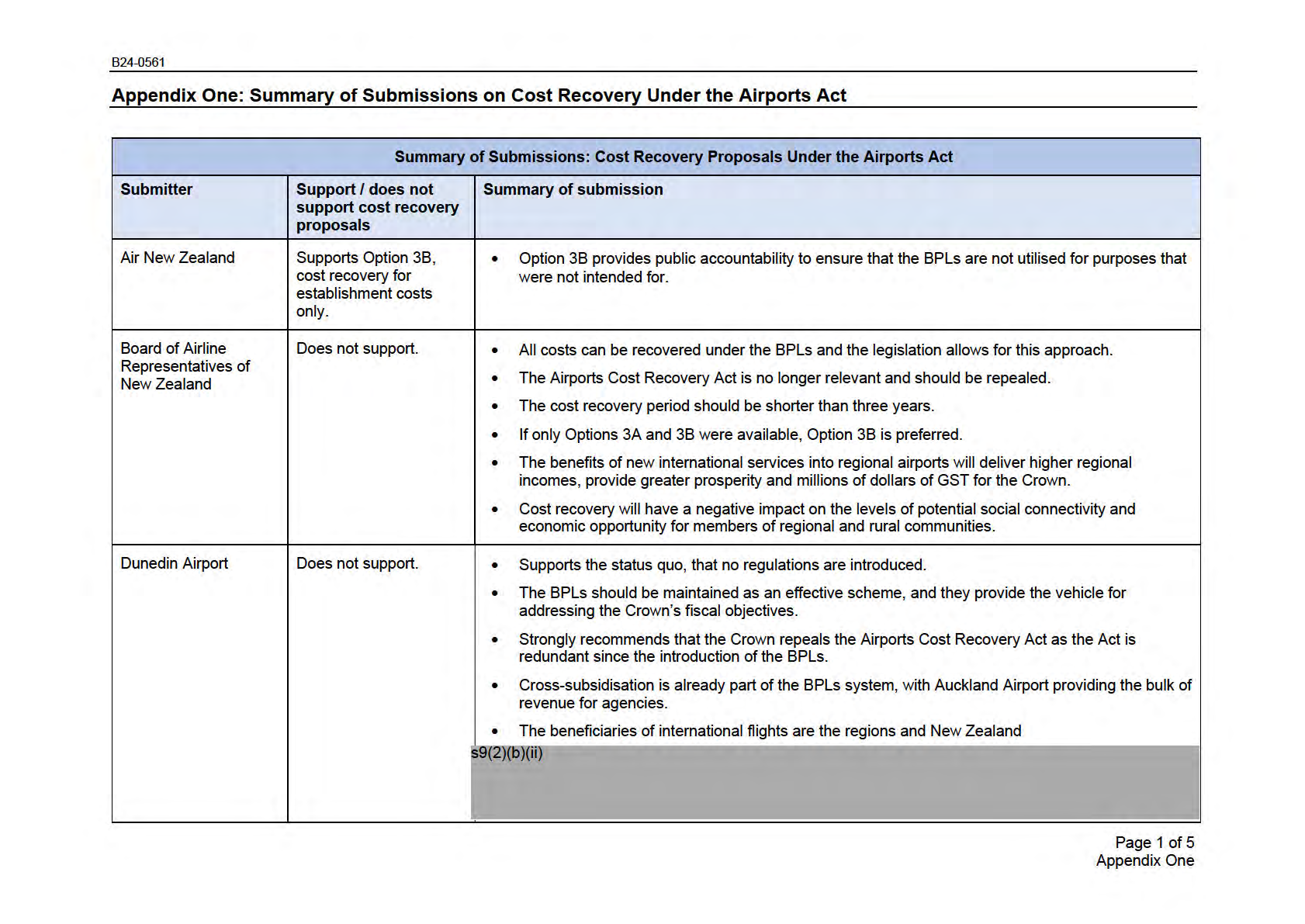
under the Official Information Act 1982
Released
B24-0561
s9(2)(b)(ii)
Far North Holdings
Did not state.
• Concerns with any potential impacts on the Bay of Islands Airport in Kerikeri, who are an
Limited
approved Place of First Arrival and receive small aircraft, who land and refuel before proceeding
to Auckland Airport.
Great South -
Does not support.
• The BPLs are the fairest and most efficient way to fund biosecurity and customs costs at
Southland Regional
international airports.
Development Agency
• The growth of Southland's aquaculture industry is driving demand for Trans-Tasman freight
services direct from Invercargill.
• The threshold for attracting airlines is high and requires significant incentivisation from airports
and support from local authority shareholders. The proposals for regulations would obstruct that
process.
Hamilton and Waikato
Does not support.
• The BPLs are the fairest and most efficient way to fund the border screenings at international
Tourism
airports.
• The regulations for cost recovery would pose a barrier to economic development of the Waikato
region.
• The threshold for attracting airlines is high and requires significant incentivisation from airports
and support from local authority shareholders. The proposals for regulations would obstruct that
process.
Invercargill Airport
Does not support.
• Supports the use of the BPLs to fund establishment costs and these being shared equally across
airports nationally.
• Raised the ability to create freight-only international operations to support
Southland's export of produce (particularly aquaculture exports)
International Air
Does not support.
• Opposes any additional burdens to airlines or airports and that costs should not be passed onto
Transport Association
airlines or customers.
under the Official Information Act 1982
• The proposals will constrict economic growth and tourism, as the competitiveness of the sector
will be impacted.
• Recovering establishment costs from airports may result in airlines looking to other international
destinations.
Page 2 of 5
Appendix One
Released
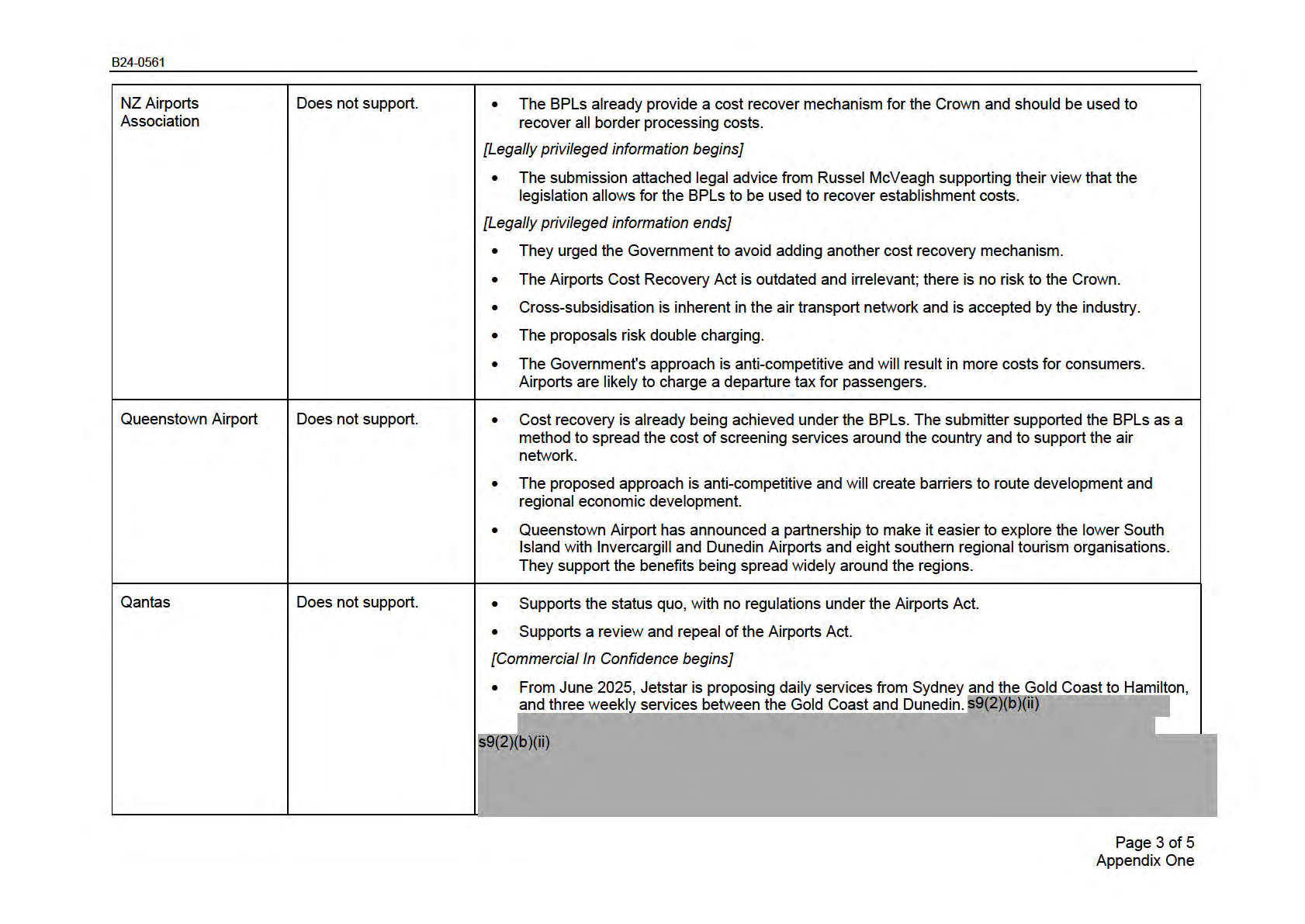
under the Official Information Act 1982
Released
B24-0561
s9(2)(b)(ii)
Rotorua Regional
Does not support.
• The Government already has structures in place for cost recovery under the BPLs. Financial
Airport & Rotorua NZ
objectives are best achieved with the BPLs, and not charges under the Airports Act.
• If regulations are used under the Airports, it will be impossible to avoid double-charging with the
BPLs.
• Encouraging growth into regional New Zealand will not only bring economic benefit to the regions,
it will reduce the pressure on roading and airport infrastructure in and around the main ports.
• From 2009 to 2015 Air New Zealand offered international services from Rotorua to Sydney. The
infrastructure to support Trans-Tasman services remains in place and Rotorua could again
facilitate these services if there was sufficient passenger demand.
• Cross-subsidisation is intrinsic within the air transport network.
• The proposals will remove competition, restrict new routes, and will compromise regional growth.
• New Zealand needs regional disbursement of international airports.
• Increasing New Zealand's tourism numbers will support double export earnings.
Shareholders of
Does not support.
• Supports the BPLs as the fairest and most efficient way to fund the biosecurity and customs
Waikato Regional
services at international airports.
Airport Limited
• The proposal would require travellers to contribute to specific costs for new or restarting
international airports, while continuing to pay BPLs for the rest of the network on top of this. This
is unfair and far less equitable than the current system.
• Concern that the regulations would be obstructive to attracting airlines to
New Zealand and to the economic development of the Waikato region.
Waikato Regional
Does not support.
• Supports the status quo and costs being funded by the BPLs.
Airport Limited
•
(Hamilton Airport)
The Airports Cost Recovery Act is redundant, and it is recommended that it is repealed.
under the Official Information Act 1982
•
The preference is for none of the options to be enacted on the basis that the Airports Cost
Recovery Act has been superseded by the BPLs. Of the preferred options, Option 3B is preferred.
Option 3A would curtail any prospect of services taking place.
Page 4 of 5
Appendix One
Released
B24-0561
• Noted that in 2018 the Civil Aviation Authority and Aviation Security Service did not proceed with
implementing a proposed site-specific cost recovery model, as it would be detrimental to the
aviation and tourism sectors.
• Acknowledged that is a risk to the Crown of asset stranding that could be mitigated by redeploying
assets and a notice period of cessation.
under the Official Information Act 1982
Page 5 of 5
Appendix One
Released
B24-0561
Appendix Two: A suggested decision path (legal privileged)
s9(2)(h)
under the Official Information Act 1982
Released
Page 1 of 1
Appendix Two
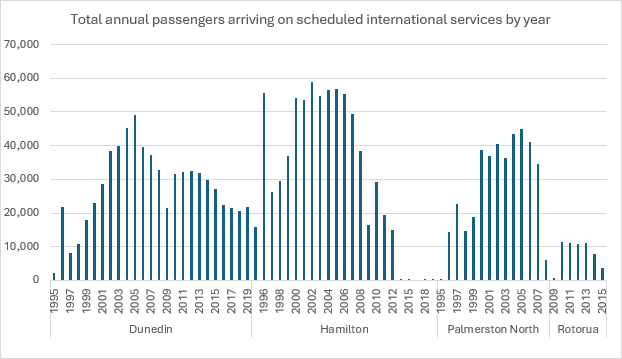
B24-0561
Appendix Three: Historical volume of passengers at regional airports that previously had international flights
The graph below provides data on the volume of passengers that arrived in Dunedin, Hamilton, Palmerston North and Rotorua Airports when they operated
international flights. The total number of incoming passengers received over the time period included:
• Dunedin (1995 to 2019): 687,614 passengers (around 28,000 passengers a year or 550 passengers per week).
• Hamilton (1996 to 2018): 722,423 passengers (around 30,000 passengers a year or 625 passengers a week).
• Palmerston North (1995 to 2008): 392,861 passengers (around 30,000 passengers a year or 580 passengers a week).
• Rotorua (2009 to 2015): 56,880 passengers (around 9,000 passengers a year or 180 passengers a week).
For comparison, the existing international airports passengers arriving at the major centres for the 12 months ended July 2024 were:
• Auckland Airport - 4,709,052 international passenger arrivals annually (around 90,000 passengers per week).
• Christchurch Airport - 1,407,019 international passenger arrivals and departures (combined figure).
• Wellington Airport - 419,344 international landed seats (around 8,000 passengers per week).
• Queenstown Airport - 436,846 international passenger arrivals (around 8,400 passengers per week).
under the Official Information Act 1982
Page 1 of 1
Appendix Three
Released

under the Official Information Act 1982
Released







